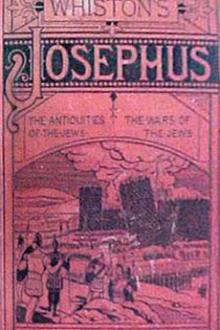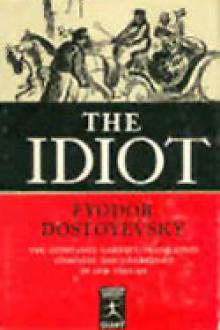The Antiquities of the Jews by Flavius Josephus (top fiction books of all time txt) 📖

- Author: Flavius Josephus
- Performer: 1600964370
Book online «The Antiquities of the Jews by Flavius Josephus (top fiction books of all time txt) 📖». Author Flavius Josephus
6 (return)
[ What Josephus here puts into his copy of Hiram's epistle to Solomon, and repeats afterwards, ch. 5. sect. 3, that Tyre was now an island, is not in any of the three other copies, viz. that of the Kings, Chronicles, or Eusebius; nor is it any other, I suppose, than his own conjectural paraphrase; for when I, many years ago, inquired into this matter, I found the state of this famous city, and of the island whereupon it stood, to have been very different at different times. The result of my inquiries in this matter, with the addition of some later improvements, stands thus: That the best testimonies hereto relating, imply, that Paketyrus, or Oldest Tyre, was no other than that most ancient smaller fort or city Tyre, situated on the continent, and mentioned in Joshua 19:29, out of which the Canaanite or Phoenician inhabitants were driven into a large island, that lay not far off in the sea, by Joshua: that this island was then joined to the continent at the present remains of Paketyrus, by a neck of land over against Solomon's cisterns, still so called; and the city's fresh water, probably, was carried along in pipes by that neck of land; and that this island was therefore, in strictness, no other than a peninsula, having villages in its fields, Ezekiel 26:6, and a wall about it, Amos 1:10, and the city was not of so great reputation as Sitlon for some ages: that it was attacked both by sea and land by Salmanasser, as Josephus informs us, Antiq. B. IX. ch. 14. sect. 2, and afterwards came to be the metropolis of Phoenicia; and was afterwards taken and destroyed by Nebuchadnezzar, according to the numerous Scripture prophecies thereto relating, Isaiah 23.; Jeremiah 25:22; 27:3; 47:4; Ezekiel 26., 27., 28.: that seventy years after that destruction by Nebuchadnezzar, this city was in some measure revived and rebuilt, Isaiah 23:17, 18, but that, as the prophet Ezekiel had foretold, chap. 26:3-5, 14; 27: 34, the sea arose higher than before, till at last it over flowed, not only the neck of land, but the main island or peninsula itself, and destroyed that old and famous city for ever: that, however, there still remained an adjoining smaller island, once connected to Old Tyre itself by Hiram, which was afterwards inhabited; to which Alexander the Great, with incredible pains, raised a new bank or causeway: and that it plainly appears from Ifaundreh, a most authentic eye-witness, that the old large and famous city, on the original large island, is now laid so generally under water, that scarce more than forty acres of it, or rather of that adjoining small island remain at this day; so that, perhaps, not above a hundredth part of the first island and city is now above water. This was foretold in the same prophecies of Ezekiel; and according to them, as Mr. Maundrell distinctly observes, these poor remains of Old Tyre are now "become like the top of a rock, a place for the spreading of nets in the midst of the sea."]
7 (return)
[ Of the temple of Solomon here described by Josephus, in this and the following sections of this chapter, see my description of the temples belonging to this work, ch. 13, These small rooms, or side chambers, seem to have been, by Josephus's description, no less than twenty cubits high a piece, otherwise there must have been a large interval between one and the other that was over it; and this with double floors, the one of six cubits distance from the floor beneath it, as 1 Kings 6:5]
8 (return)
[ Josephus says here that the cherubims were of solid gold, and only five cubits high, while our Hebrew copies [1 Kings 6;23, 28: say they were of the olive tree, and the LXXX. of the cypress tree, and only overlaid with gold; and both agree they were ten cubits high. I suppose the number here is falsely transcribed, and that Josephus wrote ten cubits also.]
9 (return)
[ As for these two famous pillars, Jachin and Booz, their height could be no more than eighteen cubits, as here, and 1 Kings 7:15; 2 Kings 25:17; Jeremiah 3:21; those thirty-five cubits in 2 Chronicles 3:15, being contrary to all the rules of architecture in the world.]
10 (return)
[ The round or cylindrical lavers of four cubits in diameter, and four in height, both in our copies, 1 Kings 7:38, 39, and here in Josephus, must have contained a great deal more than these forty baths, which are always assigned them. Where the error lies is hard to say: perhaps Josephus honestly followed his copies here, though they had been corrupted, and he was not able to restore the true reading. In the mean time, the forty baths are probably the true quantity contained in each laver, since they went upon wheels, and were to be drawn by the Levites about the courts of the priests for the washings they were designed for; and had they held much more, they would have been too heavy to have been so drawn.]
11 (return)
[ Here Josephus gives us a key to his own language, of right and left hand in the tabernacle and temple; that by the right hand he means what is against our left, when we suppose ourselves going up from the east gate of the courts towards the tabernacle or temple themselves, and so vice versa; whence it follows, that the pillar Jachin, on the right hand of the temple was on the south, against our left hand; and Booz on the north, against our right hand. Of the golden plate on the high priest's forehead that was in being in the days of Josephus, and a century or two at least later, seethe note on Antiq. B. III. ch. 7. sect. 6.]
12 (return)
[ When Josephus here says that the floor of the outmost temple or court of the Gentiles was with vast labor raised to be even, or of equal height, with the floor of the inner, or court of the priests, he must mean this in a gross estimation only; for he and all others agree, that the inner temple, or court of the priests, was a few cubits more elevated than the middle court, the court of Israel, and that much more was the court of the priests elevated several cubits above that outmost court, since the court of Israel was lower than the one and higher than the other. The Septuagint say that "they prepared timber and stones to build the temple for three years," 1 Kings 5:18; and although neither our present Hebrew copy, nor Josephus, directly name that number of years, yet do they both say the building itself did not begin till Solomon's fourth year; and both speak of the preparation of materials beforehand, 1 Kings v. 18; Antiq. B. VIII. ch. 5. sect. 1. There is no reason, therefore, to alter the Septuagint's number; but we are to suppose three years to have been the just time of the preparation, as I have done in my computation of the expense in building that temple.]
13 (return)
[ This solemn removal of the ark from Mount Sion to Mount Moriah, at the distance of almost three quarters of a mile, confutes that notion of the modern Jews, and followed by many Christians also, as if those two were after a sort one and the same mountain, for which there is, I think, very little foundation.]
14 (return)
[ This mention of the Corinthian ornaments of architecture in Solomon's palace by Josephus seems to be here set down by way of prophecy although it appears to me that the Grecian and Roman most ancient orders of architecture were taken from Solomon's temple, as from their original patterns, yet it is not so clear that the last and most ornamental order of the Corinthian was so ancient, although what the same Josephus says, [Of the War, B. V. ch. 5. sect. 3,] that one of the gates of Herod's temple was built according to the rules of this Corinthian order, is no way improbable, that order being, without dispute, much older than the reign of Herod. However, upon some trial, I confess I have not hitherto been able fully to understand the structure of this palace of Solomon, either as described in our Bibles, or even with the additional help of this description here by Josephus; only the reader may easily observe with me, that the measures of this first building in Josephus, a hundred cubits long, and fifty cubits broad, are the very same with the area of the cart of the tabernacle of Moses, and just hall' an Egyptian orout, or acre.]
15 (return)
[ This signification of the name Pharaoh appears to be true. But what Josephus adds presently, that no king of Egypt was called Pharaoh after Solomon's father-in-law, does hardly agree to our copies, which have long afterwards the names of Pharaoh Neehob, and Pharaoh Hophrah, 2 Kings 23:29; Jeremiah 44:30, besides the frequent mention of that name Pharaoh in the prophets. However, Josephus himself, in his own speech to the Jews, Of the War, B. V. ch. 9. sect. 4, speaks of Neehao, who was also called Pharaoh, as the name of that king of Egypt with whom Abraham was concerned; of which name Neehao yet we have elsewhere no mention till the days of Josiah, but only of Pharaoh. And, indeed, it must be conceded, that here, and sect. 5, we have more mistakes made by Josephus, and those relating to the kings of Egypt, and to that queen of Egypt and Ethiopia, whom he supposes to have come to see Solomon, than almost any where else in all his Antiquities.]
16 (return)
[ That this queen of Sheba was a queen of Sabea in South Arabia, and not of Egypt and Ethiopia, as Josephus here asserts, is, I suppose, now generally agreed. And since Sabea is well known to be a country near the sea in the south of Arabia Felix, which lay south from Judea also; and since our Savior calls this queen, "the queen of the south," and says, "she came from the utmost parts of the earth," Matthew 12:42; Luke 11:31, which descriptions agree better to this Arabia than to Egypt and Ethiopia; there is little occasion for doubting in this matter.]
17 (return)
[ Some blame Josephus for supposing that the balsam tree might be first brought out of Arabia, or Egypt, or Ethiopia, into Judea, by this queen of Sheba, since several have said that of old no country bore this precious balsam but Judea; yet it is not only false that this balsam was peculiar to Judea but both Egypt and Arabia, and particularly Sabea; had it; which last was that very country whence Josephus, if understood not of Ethiopia, but of Arabia, intimates this queen might bring it first into Judea. Nor are we to suppose that the queen of Sabaea could well omit such a present as this balsam tree would be esteemed by Solomon, in case it were then almost peculiar to her own country. Nor is the mention of balm or balsam, as carried by merchants, and sent as a present out of Judea by Jacob, to the governor of Egypt, Genesis 37:25; 43:11, to be alleged to the contrary, since what we there render balm or balsam, denotes rather that turpentine which we now call turpentine of





Comments (0)